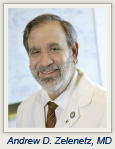 The findings of RESORT1 have tremendous implications, both clinically and economically, commented Andrew D. Zelenetz, MD, Chief of the Lymphoma Service at Memorial Sloan-Kettering Cancer Center, New York, in an interview.
The findings of RESORT1 have tremendous implications, both clinically and economically, commented Andrew D. Zelenetz, MD, Chief of the Lymphoma Service at Memorial Sloan-Kettering Cancer Center, New York, in an interview.
“The maintenance arm received rituximab [Rituxan] every 3 months indefinitely, for a median of 16 doses, while retreated patients received 4 doses. We are in an era when, without question, we have to figure out how to give effective high-quality care without breaking the bank. Retreatment may give us the same benefit at a much lower cost,” he said.
Trial Could Shake up Standard of Care
The results suggest the clinical outcomes are similar, and “this will raise questions for some,” he suggested, referring to the population of hematologists accustomed to giving maintenance rituximab as the standard of care. According to Dr. Zelenetz, 72% of attendees at an ASH satellite symposium indicated they routinely prescribe maintenance.
“Some people in the field say that maintenance is unequivocally the standard of care. I happen not to share that opinion,” Dr. Zelenetz told The ASCO Post. “The guidelines of the National Comprehensive Cancer Network suggest that maintenance is an option, and not mandatory, because it delays progression and time to next treatment but it does not impact overall survival.”
The lack of survival benefit might stem from the observation that “the more treatment you use up front, the less effective it is going to be out back,” Dr. Zelenetz added. “RESORT raises the question of whether it might make more sense to re-treat when necessary rather than give rituximab automatically, to derive the same benefit and probably at a much lower cost.”
Trial Is Confirmatory, Will Produce Useful Data
 Joseph M. Connors, MD, Clinical Director of the British Columbia Cancer Agency Centre for Lymphoid Cancer, Vancouver, told The ASCO Post that data from RESORT are “entirely congruent with other studies suggesting that today’s patients with follicular lymphoma who previously were thought best initially managed with watchful waiting may do at least as well if initially treated with rituximab.”
Joseph M. Connors, MD, Clinical Director of the British Columbia Cancer Agency Centre for Lymphoid Cancer, Vancouver, told The ASCO Post that data from RESORT are “entirely congruent with other studies suggesting that today’s patients with follicular lymphoma who previously were thought best initially managed with watchful waiting may do at least as well if initially treated with rituximab.”
Just 10 years ago, he continued, “Ardeshna and colleagues reported 5-year mortality of over 40% for the watchful waiting control arm.2 Today, as reported in the RESORT trial and in the control (watchful waiting) arm of a more recent study led by Ardeshna,3 5-year mortality is less than 10%,” he said. “This improvement is due to a constellation of different factors, especially improvements in primary treatment once the lymphoma becomes symptomatic, incorporation of maintenance rituximab after primary chemotherapy plus rituximab, and better management of recurrent disease. Overall, we are better at managing follicular lymphoma and these patients do well.”
Presently, investigators are looking for a strategy that allows patients who otherwise might be considered for watchful waiting to avoid treatments that are more toxic than initial rituximab, Dr. Connors noted. “The RESORT trial, taken together with the more recent Ardeshna trial, helps identify a strategy involving a short course of ritixumab, with the drug then reserved until needed (vs continuous treatment), as quite attractive. This approach may produce the highest quality of life with the least amount of treatment and lowest cost, yet still keep patients alive and free of additional treatments.”
Dr. Connors did have one reservation concerning RESORT: The combination of patients who had already been under a watchful waiting policy with newly diagnosed patients. “Once a patient has a track record of his or her disease not progressing, or very slowly progressing, it is likely to continue to behave that way, no matter the intervention,” he pointed out. “We need to know the proportion of patients in each of these groups and to determine if their outcomes are different. We all have patients under watching waiting now, and we question whether we should put them on rituximab after having watched them for some time. We hope this study will eventually provide some answers to this question.” ■
Disclosure: Dr. Connors’ institution receives funding for research and clinical trials from Roche Canada. Dr. Zelenetz serves as a consultant for Genentech/Roche.
References
1. Kahl B, Hong F, Williams ME, et al: Results of Eastern Cooperative Oncology Group Protocol E4402 (RESORT): A randomized phase III study comparing two different rituximab dosing strategies for low tumor burden follicular lymphoma. 53rd American Society of Hematology Annual Meeting. Abstract LBA-6. Presented December 13, 2011.
2. Ardeshna KM, Smith P, Norton A, et al: Long-term effect of a watch and wait policy versus immediate systemic treatment for asymptomatic advanced-stage non-Hodgkin lymphoma: a randomized controlled trial. Lancet 362:615-622, 2003.
3. Ardeshna KM, Smith P, Qian W, et al: An Intergroup Randomised Trial of Rituximab Versus a Watch and Wait Strategy In Patients with Stage II, III, IV, Asymptomatic, Non-Bulky Follicular Lymphoma (Grades 1, 2 and 3a). A Preliminary Analysis. 52nd American Society of Hematology Annual Meeting. Abstract 6. Presented December 5, 2010.

 Given the excellent outcomes, lack of a...
Given the excellent outcomes, lack of a...